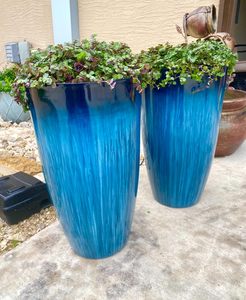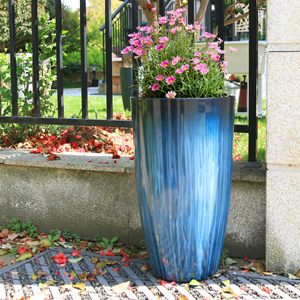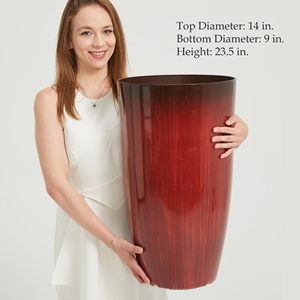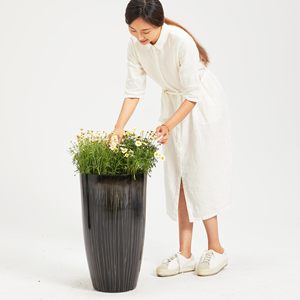
All categories
Featured selections
Trade Assurance
Buyer Central
Help Center
Get the app
Become a supplier

(2280 products available)




















































The various kinds of plastic rectangular planters that can be found in the market have been categorized based on their material composition, and this classification will help to understand their specific features and advantages:
High-Density Polyethylene (HDPE)
HDPE is a commonly used plastic material for producing rectangular planters. The planters made from HDPE can withstand extreme temperatures and are not vulnerable to ultraviolet (UV) rays. They are also resistant to chemicals, and this makes them a suitable choice for both indoor and outdoor use. Additionally, HDPE planters are recyclable. These planters are lightweight and have a high level of impact resistance. They also have a low likelihood of getting rust or corrosion, which makes them a durable and long-lasting option for gardening enthusiasts.
Polypropylene (PP)
Rectangular planters made from polypropylene are also a popular choice among users. These planters are water and chemical resistant, and they can easily be exposed to harsh weather conditions. This type of planter is lightweight, and it has a high level of durability. Planters made from PP are easily recyclable, and this adds to their eco-friendliness. Moreover, they have a low likelihood of getting wear and tear, which provides them with a longer lifespan compared to other planter types.
Acrylic (PMMA)
Acrylic planters are known for their transparency and glass-like appearance. They are lightweight and have good impact resistance. While not as UV-resistant as other materials, acrylic planters are suitable for indoor use or shaded outdoor areas. They are easy to clean and maintain. Acrylic planters are often available in various colors and can provide a vibrant addition to indoor and outdoor spaces.
Polyvinyl Chloride (PVC)
PVC planters are affordable and durable. They are water and chemical resistant, making them suitable for various gardening applications. PVC planters are often used in commercial settings and are known for their practicality. They can be easily installed and maintained, and they are available in different sizes and shapes to accommodate various planting needs.
Recycled Plastic
With the growing concern for environmental sustainability, planters made from recycled plastics have come into the picture. These planters are manufactured using post-consumer and post-industrial recycled plastics. This means that the plastic waste that could have harmed the environment is transformed into usable planter products instead. These planters are eco-friendly options for users who want to contribute positively to the environment. They have a comparable quality and features to those of conventional plastic planters.
The design of the large rectangle planters is made to meet the needs of the users and the plants. They are trendy and look good, but they also help the plants grow well.
Aesthetics and Style Options
Plastic rectangular planters come in various styles, colors, and finishes, allowing them to complement any indoor or outdoor decor. They can have a sleek and modern look or mimic natural materials like wood or stone. This versatility allows homeowners and gardeners to express their style while creating beautiful green spaces.
Functional Design Elements
Plastic rectangular planters are designed with practicality. Many have built-in drainage systems that prevent overwatering and root rot. Some pots also have self-watering features, allowing plants to absorb water as needed. The lightweight nature of plastic makes it easy to move and rearrange planters, making them perfect for experimenting with different plant displays.
UV Protection and Weather Resistance
High-quality plastic planters are made to withstand harsh sunlight and changing weather conditions. They are resistant to fading, cracking, and warping, ensuring they last for many years, even in outdoor settings.
Customization and Personalization
Plastic planters can be customized to fit individual preferences. Stickers, paint, or special planter covers can be used to add a personal touch. They can also be modified by adding accessories like trellises or hanging baskets.
Sustainability and Eco-Friendly Options
The rectangular planters are designed to be eco-friendly. They are made from recycled plastic or designed to be recycled. This reduces the environmental impact and supports sustainable gardening practices.
In short, the design of plastic rectangle planters is a good mix of style and usefulness. They look nice and are made to help plants grow better. With options for durability, customization, and sustainability, plastic rectangular planters are a smart choice for anyone who wants to make their living space greener.
Plastic rectangle planters are versatile and practical for various gardening needs. They are excellent for:
Container gardening
Container gardening involves planting within containers instead of directly into the ground. This method allows people to garden in small spaces, such as balconies, patios, or rooftops, where traditional gardening may not be possible. Plastic rectangle planters are a great choice for container gardening because they are lightweight, affordable, and come in many sizes and shapes to fit different plants and spaces. Whether growing herbs, flowers, or vegetables, container gardening with plastic planters makes it easy to care for plants and move them around as needed.
Vegetable and herb gardens
Vegetable and herb gardens provide fresh produce and add flavor to meals. Plastic rectangle planters work well for these gardens, too. They allow people to grow vegetables and herbs, even in places with limited soil or poor ground conditions. Using planters for vegetable and herb gardens can also help keep plants cleaner and make it easier to manage pests and weeds. Plus, these planters can be placed at convenient heights, reducing the need to bend over or kneel down.
Ornamental gardens
Ornamental gardens are designed mainly for beauty and can include various flowers, shrubs, and other plants. Using plastic rectangle planters in these gardens makes it easy to arrange things nicely and keep everything looking neat. Planters can be moved around to change the garden's appearance or to follow the sun for plants that need more light. Putting ornamental plants in planters can also protect them from some ground pests and diseases.
Indoor gardening
Indoor gardening means growing plants inside the home. With the rise in popularity of indoor gardening, planers have become an essential tool for homeowners and renters to bring a touch of greenery into their living spaces. Indoor rectangle planters can hold various houseplants, from ferns and peace lilies to snake plants and pothos. They allow people to display plants on floors, shelves, or tabletops, enhancing the home's decor and improving air quality.
Vertical gardens
Vertical gardens are wall-mounted gardens that save space and create a living wall effect. Planers are usually equipped with drainage holes at the bottom that allow water to flow out of the containers, preventing waterlogging and ensuring healthy root growth. Moreover, planters are lightweight and easy to move, making them suitable for both permanent and temporary installations. Whether creating a permanent installation in a backyard or a temporary pop-up in an event space, plastic planers can adapt to changing circumstances.
From the material to the drainage system, many factors must be considered when selecting the planters. This is a summary of the key factors to consider when choosing the planters.
Materials
The most common materials for plastic rectangle planters are PVC, PE, and PS. PVC planters are very durable and can withstand extreme weather conditions. PE planters are lightweight and easy to carry, while PS planters have a smooth and glossy finish, making them look more elegant.
Drainage
Most planters do not have enough drainage holes. Proper drainage is essential to prevent overwatering and root rot. Consider using a plastic rectangle planter with a removable bottom or a sub-irrigation system to ensure adequate drainage.
Size and weight
Plastic rectangle planters can be very heavy, especially when filled with soil and water. Consider the weight factor when choosing a planter. Additionally, ensure the planter has enough space for the plants' roots to grow. Remember that the size of the rectangle planter is also critical. It is advisable to choose a planter that is at least twice the width and depth of the plant's root ball.
Aesthetics
Choose planters that complement the space's overall look and feel. Consider the color, texture, and finish of the planters. The style can also impact the planters' aesthetics. Modern planters have clean lines and geometric shapes, while rustic planters have more earthy tones and textured finishes.
Customization
Customizable planters are available for those who want to make a unique statement with their planters. These rectangle planters can be modified to fit specific needs and preferences. Customizable planters are also great for branding and marketing purposes.
Environmental impact
Choose planters made from recycled materials or planters that can be recycled after use. Some manufacturers produce eco-friendly planters made from biodegradable materials.
Q1: Can plastic rectangular planters be used indoors and outdoors?
A1: Yes, plastic rectangle planters are suitable for both indoor and outdoor use. They are a versatile planting solution that can be used in various settings.
Q2: Do plastic rectangle planters require drainage?
A2: Yes, plastic rectangle planters need drainage to prevent waterlogging and root rot. Choose planters with drainage holes, and consider adding a drainage layer of pebbles or gravel at the bottom.
Q3: Are plastic rectangle planters eco-friendly?
A3: Many modern plastic rectangle planters are made from recycled plastic and are recyclable, making them more environmentally friendly. Look for products with eco-friendly certifications.
Q4: Can plastic rectangle planters be left outside in winter?
A4: Most plastic planters can withstand winter temperatures; however, frozen soil can expand and contract, potentially damaging the container. It may be beneficial to bring planters inside during extreme winter weather.
Q5: How can stains on plastic rectangle planters be removed?
A5: Clean planters with a mild dish soap and water solution to remove stains. For stubborn stains, baking soda or vinegar can be used as a gentle abrasive.